Book Review: Reading the Bible with Heart and Mind - Report
VerifiedAdded on 2020/04/15
|7
|1415
|73
Report
AI Summary
This report is a book review of 'Reading the Bible with Heart and Mind,' which aims to revitalize Christian faith by emphasizing thoughtful engagement with scripture. The review is divided into four sections, discussing the Bible's transformative power, the necessity of a receptive heart, characteristics of a reader with faith, and principles for interpretation. The book critiques approaches like bibliolatry, literalism, and cultural conformity, advocating for a balanced interpretation that considers historical context and authorial intent. The reviewer highlights the book's persuasive style and focus on applying biblical principles, while also pointing out some inconsistencies and verbose writing. Overall, the book is praised for its engaging discussion on Bible reading, offering valuable insights for readers seeking a deeper understanding of scripture and its relevance to contemporary life. The review also touches on the author's background, his perspective on various theological and social issues and overall impact of the book.
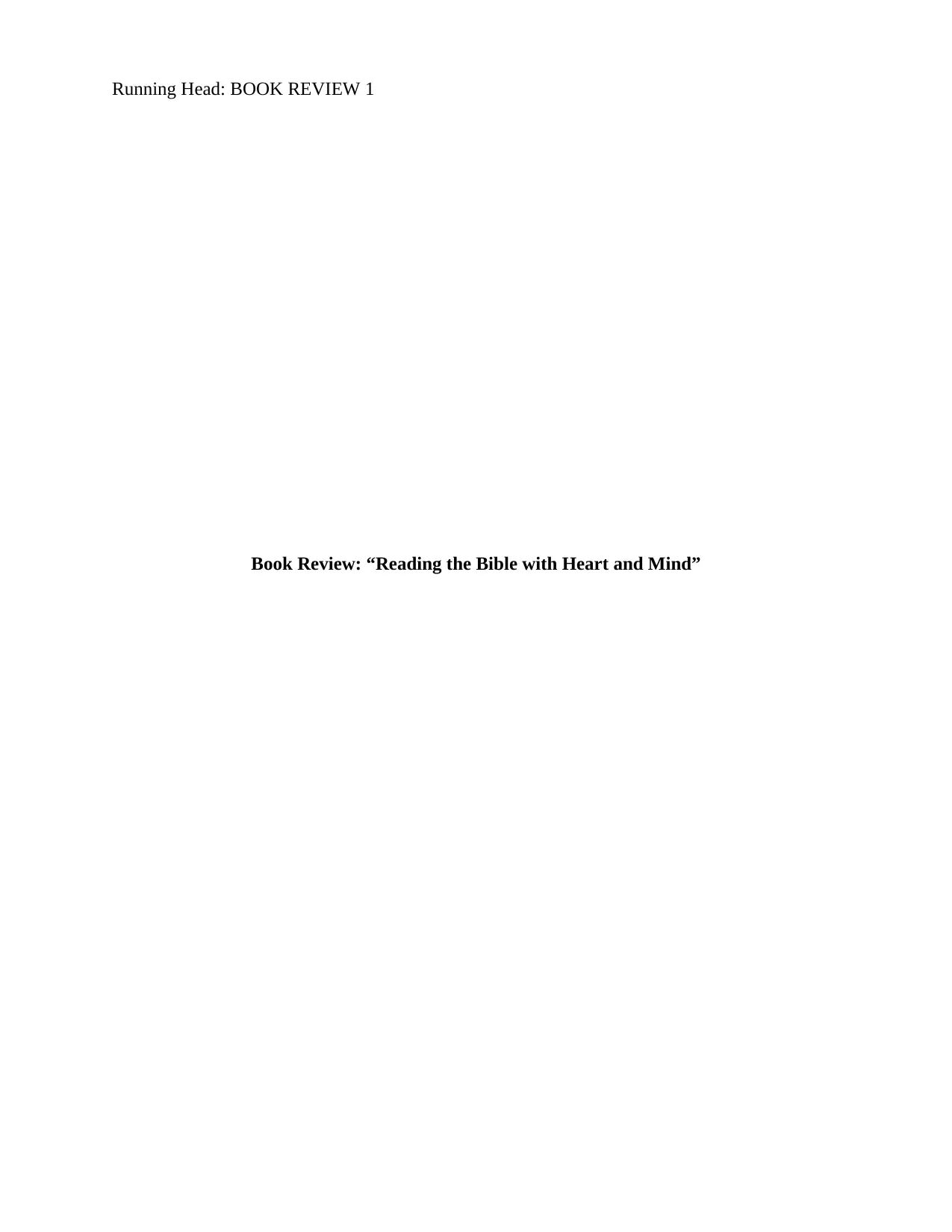
Running Head: BOOK REVIEW 1
Book Review: “Reading the Bible with Heart and Mind”
Book Review: “Reading the Bible with Heart and Mind”
Paraphrase This Document
Need a fresh take? Get an instant paraphrase of this document with our AI Paraphraser

Book Review 2
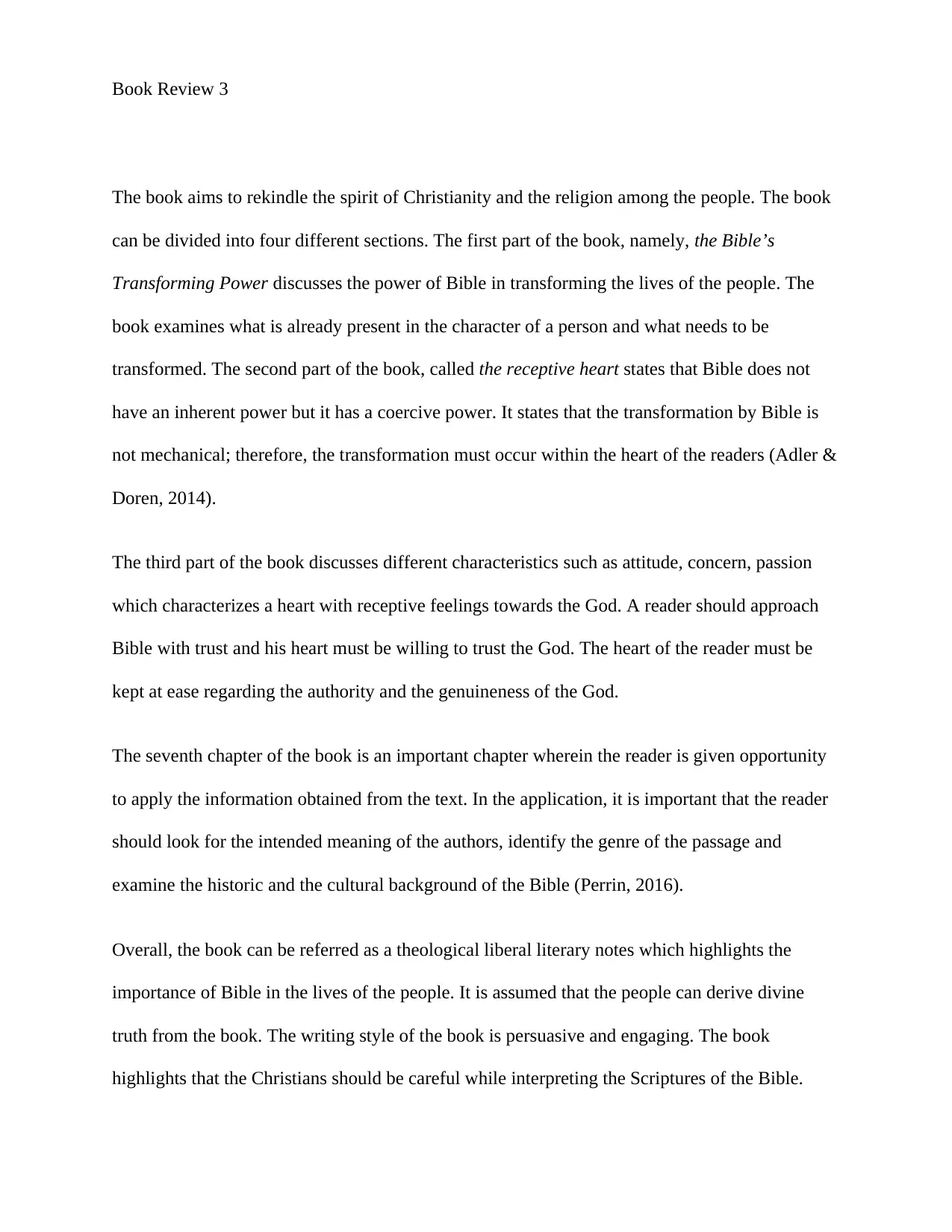
Book Review 3
The book aims to rekindle the spirit of Christianity and the religion among the people. The book
can be divided into four different sections. The first part of the book, namely, the Bible’s
Transforming Power discusses the power of Bible in transforming the lives of the people. The
book examines what is already present in the character of a person and what needs to be
transformed. The second part of the book, called the receptive heart states that Bible does not
have an inherent power but it has a coercive power. It states that the transformation by Bible is
not mechanical; therefore, the transformation must occur within the heart of the readers (Adler &
Doren, 2014).
The third part of the book discusses different characteristics such as attitude, concern, passion
which characterizes a heart with receptive feelings towards the God. A reader should approach
Bible with trust and his heart must be willing to trust the God. The heart of the reader must be
kept at ease regarding the authority and the genuineness of the God.
The seventh chapter of the book is an important chapter wherein the reader is given opportunity
to apply the information obtained from the text. In the application, it is important that the reader
should look for the intended meaning of the authors, identify the genre of the passage and
examine the historic and the cultural background of the Bible (Perrin, 2016).
Overall, the book can be referred as a theological liberal literary notes which highlights the
importance of Bible in the lives of the people. It is assumed that the people can derive divine
truth from the book. The writing style of the book is persuasive and engaging. The book
highlights that the Christians should be careful while interpreting the Scriptures of the Bible.
The book aims to rekindle the spirit of Christianity and the religion among the people. The book
can be divided into four different sections. The first part of the book, namely, the Bible’s
Transforming Power discusses the power of Bible in transforming the lives of the people. The
book examines what is already present in the character of a person and what needs to be
transformed. The second part of the book, called the receptive heart states that Bible does not
have an inherent power but it has a coercive power. It states that the transformation by Bible is
not mechanical; therefore, the transformation must occur within the heart of the readers (Adler &
Doren, 2014).
The third part of the book discusses different characteristics such as attitude, concern, passion
which characterizes a heart with receptive feelings towards the God. A reader should approach
Bible with trust and his heart must be willing to trust the God. The heart of the reader must be
kept at ease regarding the authority and the genuineness of the God.
The seventh chapter of the book is an important chapter wherein the reader is given opportunity
to apply the information obtained from the text. In the application, it is important that the reader
should look for the intended meaning of the authors, identify the genre of the passage and
examine the historic and the cultural background of the Bible (Perrin, 2016).
Overall, the book can be referred as a theological liberal literary notes which highlights the
importance of Bible in the lives of the people. It is assumed that the people can derive divine
truth from the book. The writing style of the book is persuasive and engaging. The book
highlights that the Christians should be careful while interpreting the Scriptures of the Bible.
⊘ This is a preview!⊘
Do you want full access?
Subscribe today to unlock all pages.

Trusted by 1+ million students worldwide
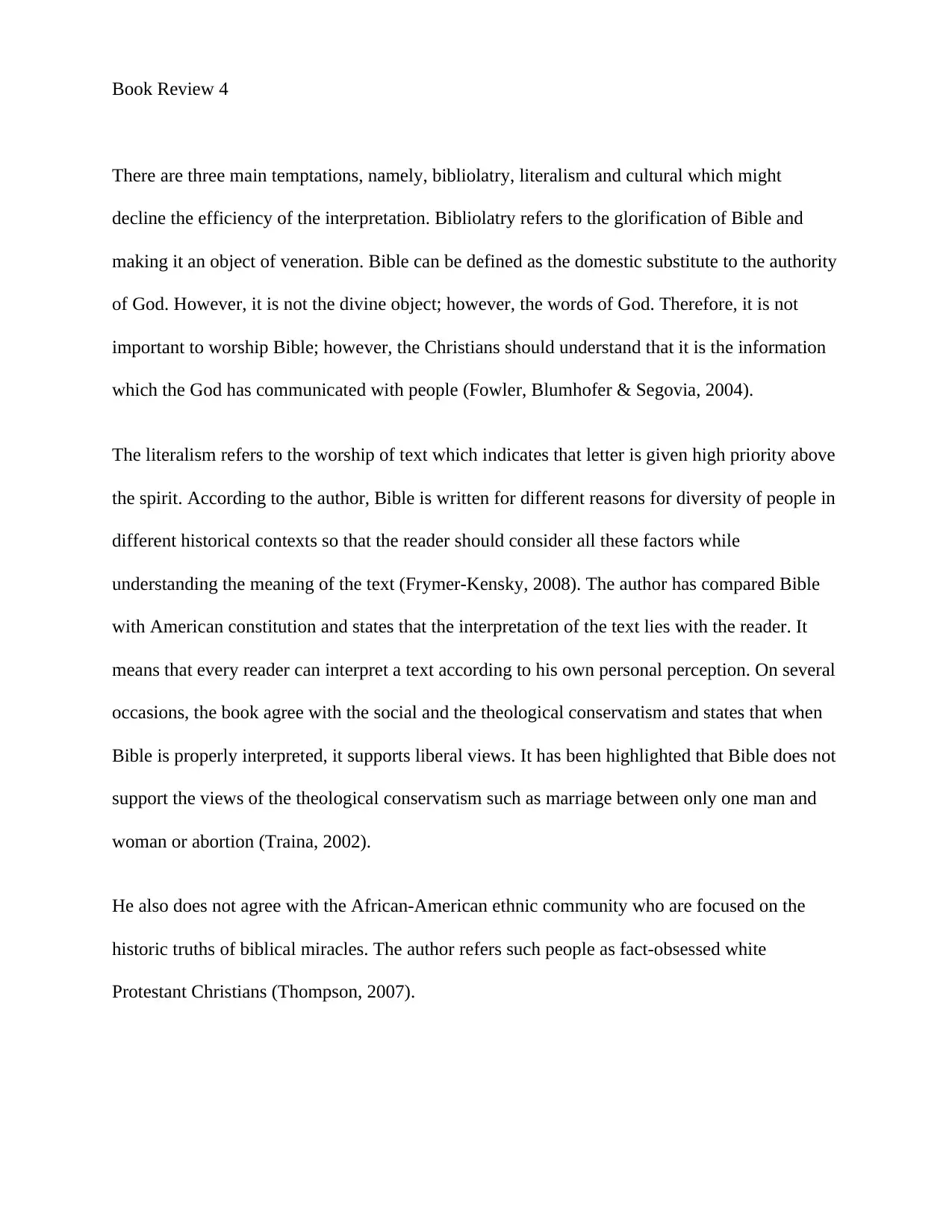
Book Review 4
There are three main temptations, namely, bibliolatry, literalism and cultural which might
decline the efficiency of the interpretation. Bibliolatry refers to the glorification of Bible and
making it an object of veneration. Bible can be defined as the domestic substitute to the authority
of God. However, it is not the divine object; however, the words of God. Therefore, it is not
important to worship Bible; however, the Christians should understand that it is the information
which the God has communicated with people (Fowler, Blumhofer & Segovia, 2004).
The literalism refers to the worship of text which indicates that letter is given high priority above
the spirit. According to the author, Bible is written for different reasons for diversity of people in
different historical contexts so that the reader should consider all these factors while
understanding the meaning of the text (Frymer-Kensky, 2008). The author has compared Bible
with American constitution and states that the interpretation of the text lies with the reader. It
means that every reader can interpret a text according to his own personal perception. On several
occasions, the book agree with the social and the theological conservatism and states that when
Bible is properly interpreted, it supports liberal views. It has been highlighted that Bible does not
support the views of the theological conservatism such as marriage between only one man and
woman or abortion (Traina, 2002).
He also does not agree with the African-American ethnic community who are focused on the
historic truths of biblical miracles. The author refers such people as fact-obsessed white
Protestant Christians (Thompson, 2007).
There are three main temptations, namely, bibliolatry, literalism and cultural which might
decline the efficiency of the interpretation. Bibliolatry refers to the glorification of Bible and
making it an object of veneration. Bible can be defined as the domestic substitute to the authority
of God. However, it is not the divine object; however, the words of God. Therefore, it is not
important to worship Bible; however, the Christians should understand that it is the information
which the God has communicated with people (Fowler, Blumhofer & Segovia, 2004).
The literalism refers to the worship of text which indicates that letter is given high priority above
the spirit. According to the author, Bible is written for different reasons for diversity of people in
different historical contexts so that the reader should consider all these factors while
understanding the meaning of the text (Frymer-Kensky, 2008). The author has compared Bible
with American constitution and states that the interpretation of the text lies with the reader. It
means that every reader can interpret a text according to his own personal perception. On several
occasions, the book agree with the social and the theological conservatism and states that when
Bible is properly interpreted, it supports liberal views. It has been highlighted that Bible does not
support the views of the theological conservatism such as marriage between only one man and
woman or abortion (Traina, 2002).
He also does not agree with the African-American ethnic community who are focused on the
historic truths of biblical miracles. The author refers such people as fact-obsessed white
Protestant Christians (Thompson, 2007).
Paraphrase This Document
Need a fresh take? Get an instant paraphrase of this document with our AI Paraphraser
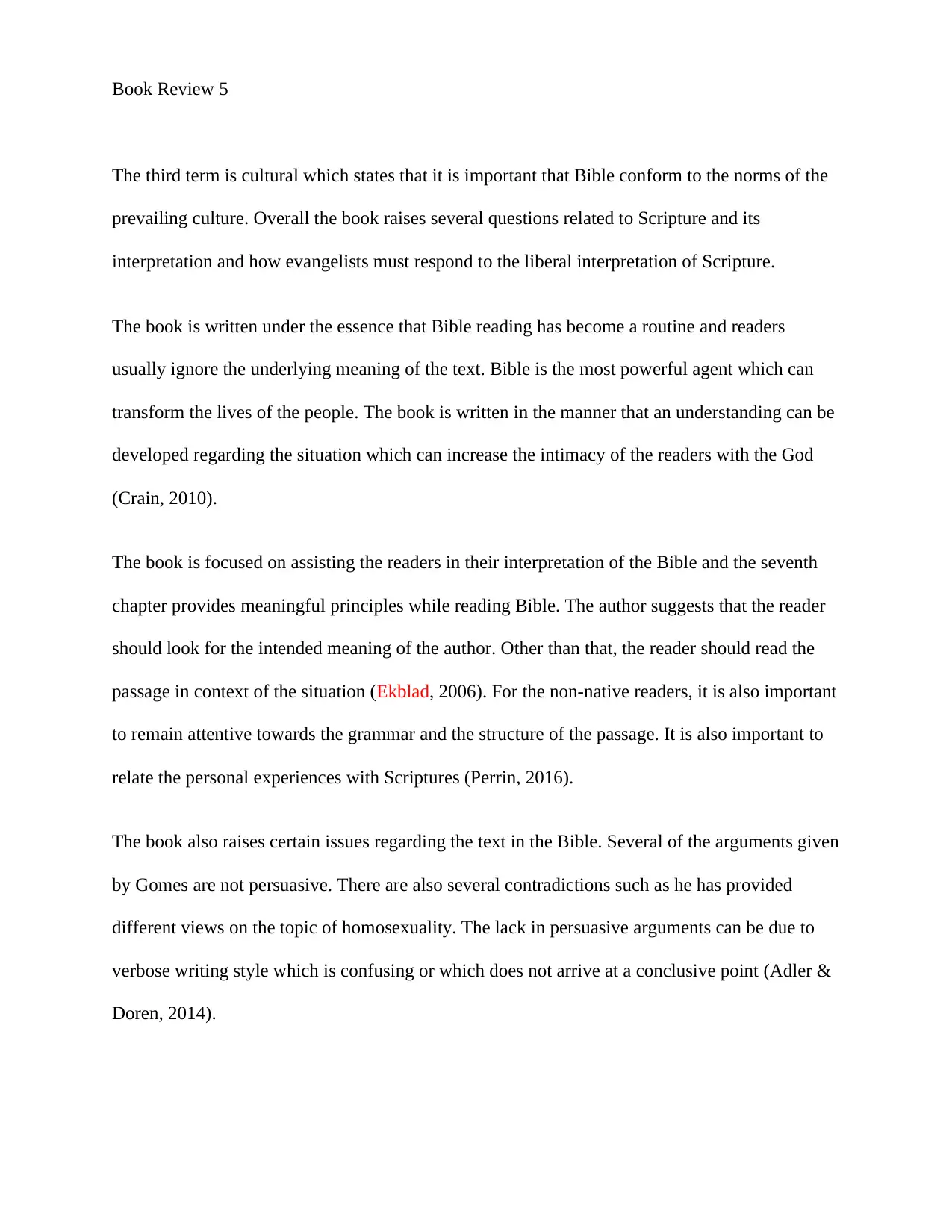
Book Review 5
The third term is cultural which states that it is important that Bible conform to the norms of the
prevailing culture. Overall the book raises several questions related to Scripture and its
interpretation and how evangelists must respond to the liberal interpretation of Scripture.
The book is written under the essence that Bible reading has become a routine and readers
usually ignore the underlying meaning of the text. Bible is the most powerful agent which can
transform the lives of the people. The book is written in the manner that an understanding can be
developed regarding the situation which can increase the intimacy of the readers with the God
(Crain, 2010).
The book is focused on assisting the readers in their interpretation of the Bible and the seventh
chapter provides meaningful principles while reading Bible. The author suggests that the reader
should look for the intended meaning of the author. Other than that, the reader should read the
passage in context of the situation (Ekblad, 2006). For the non-native readers, it is also important
to remain attentive towards the grammar and the structure of the passage. It is also important to
relate the personal experiences with Scriptures (Perrin, 2016).
The book also raises certain issues regarding the text in the Bible. Several of the arguments given
by Gomes are not persuasive. There are also several contradictions such as he has provided
different views on the topic of homosexuality. The lack in persuasive arguments can be due to
verbose writing style which is confusing or which does not arrive at a conclusive point (Adler &
Doren, 2014).
The third term is cultural which states that it is important that Bible conform to the norms of the
prevailing culture. Overall the book raises several questions related to Scripture and its
interpretation and how evangelists must respond to the liberal interpretation of Scripture.
The book is written under the essence that Bible reading has become a routine and readers
usually ignore the underlying meaning of the text. Bible is the most powerful agent which can
transform the lives of the people. The book is written in the manner that an understanding can be
developed regarding the situation which can increase the intimacy of the readers with the God
(Crain, 2010).
The book is focused on assisting the readers in their interpretation of the Bible and the seventh
chapter provides meaningful principles while reading Bible. The author suggests that the reader
should look for the intended meaning of the author. Other than that, the reader should read the
passage in context of the situation (Ekblad, 2006). For the non-native readers, it is also important
to remain attentive towards the grammar and the structure of the passage. It is also important to
relate the personal experiences with Scriptures (Perrin, 2016).
The book also raises certain issues regarding the text in the Bible. Several of the arguments given
by Gomes are not persuasive. There are also several contradictions such as he has provided
different views on the topic of homosexuality. The lack in persuasive arguments can be due to
verbose writing style which is confusing or which does not arrive at a conclusive point (Adler &
Doren, 2014).
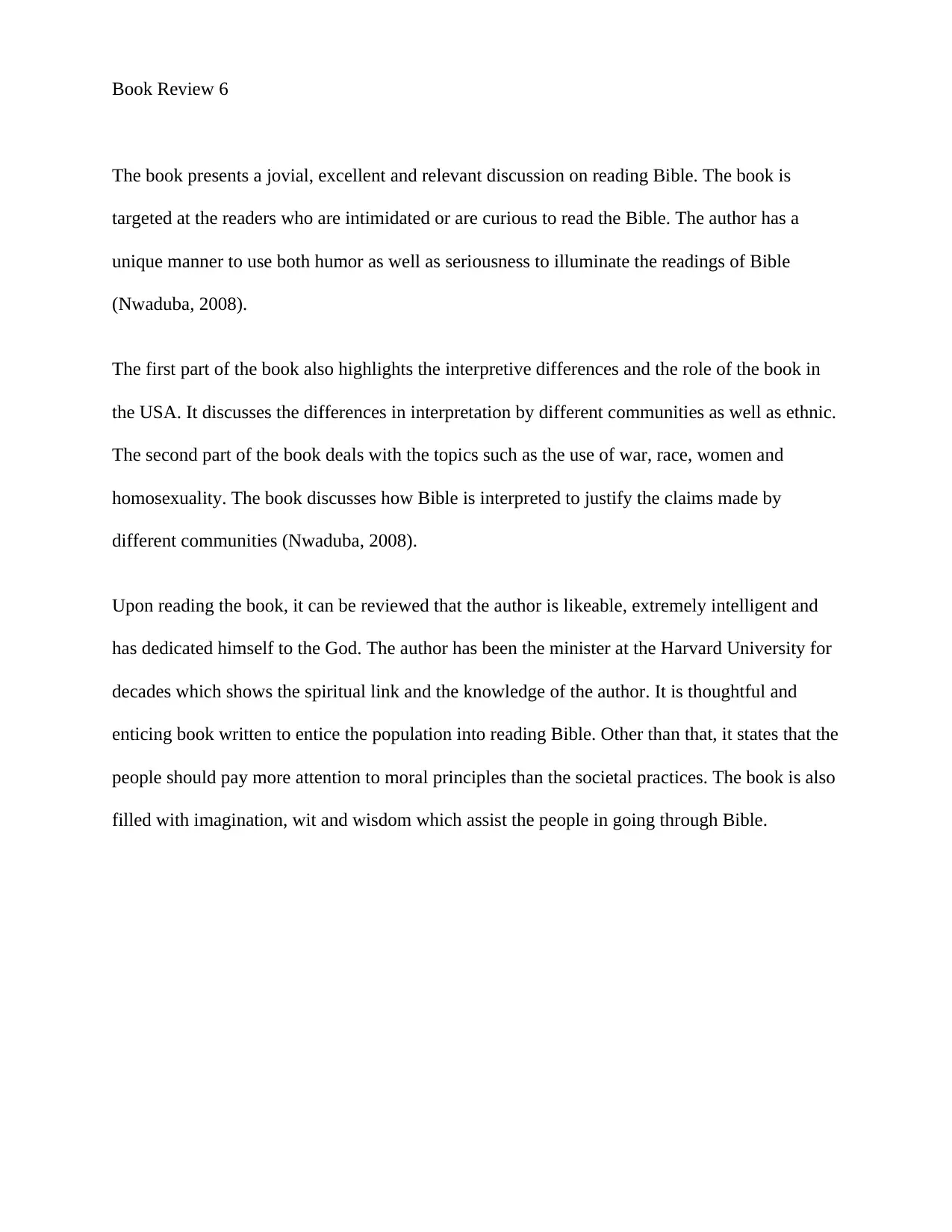
Book Review 6
The book presents a jovial, excellent and relevant discussion on reading Bible. The book is
targeted at the readers who are intimidated or are curious to read the Bible. The author has a
unique manner to use both humor as well as seriousness to illuminate the readings of Bible
(Nwaduba, 2008).
The first part of the book also highlights the interpretive differences and the role of the book in
the USA. It discusses the differences in interpretation by different communities as well as ethnic.
The second part of the book deals with the topics such as the use of war, race, women and
homosexuality. The book discusses how Bible is interpreted to justify the claims made by
different communities (Nwaduba, 2008).
Upon reading the book, it can be reviewed that the author is likeable, extremely intelligent and
has dedicated himself to the God. The author has been the minister at the Harvard University for
decades which shows the spiritual link and the knowledge of the author. It is thoughtful and
enticing book written to entice the population into reading Bible. Other than that, it states that the
people should pay more attention to moral principles than the societal practices. The book is also
filled with imagination, wit and wisdom which assist the people in going through Bible.
The book presents a jovial, excellent and relevant discussion on reading Bible. The book is
targeted at the readers who are intimidated or are curious to read the Bible. The author has a
unique manner to use both humor as well as seriousness to illuminate the readings of Bible
(Nwaduba, 2008).
The first part of the book also highlights the interpretive differences and the role of the book in
the USA. It discusses the differences in interpretation by different communities as well as ethnic.
The second part of the book deals with the topics such as the use of war, race, women and
homosexuality. The book discusses how Bible is interpreted to justify the claims made by
different communities (Nwaduba, 2008).
Upon reading the book, it can be reviewed that the author is likeable, extremely intelligent and
has dedicated himself to the God. The author has been the minister at the Harvard University for
decades which shows the spiritual link and the knowledge of the author. It is thoughtful and
enticing book written to entice the population into reading Bible. Other than that, it states that the
people should pay more attention to moral principles than the societal practices. The book is also
filled with imagination, wit and wisdom which assist the people in going through Bible.
⊘ This is a preview!⊘
Do you want full access?
Subscribe today to unlock all pages.

Trusted by 1+ million students worldwide
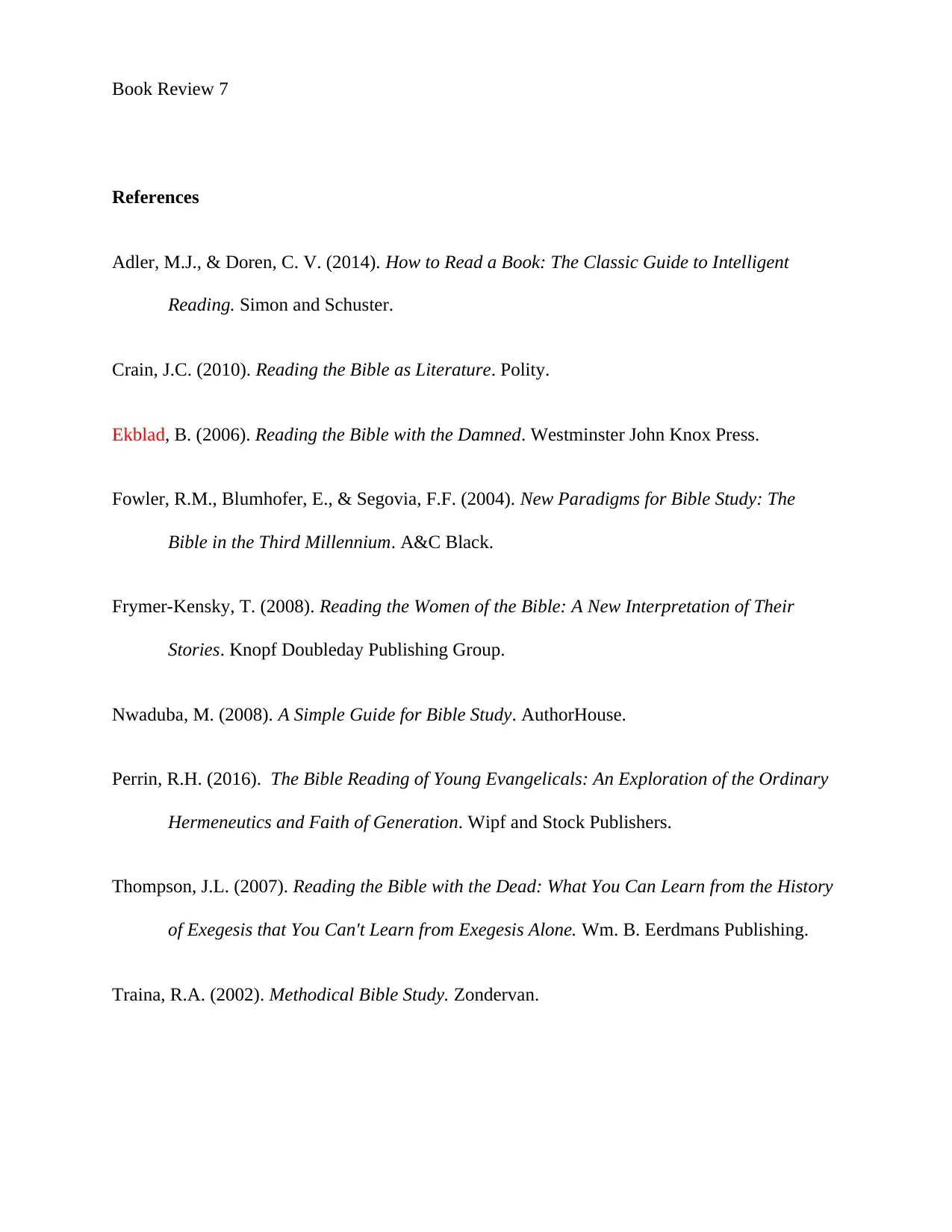
Book Review 7
References
Adler, M.J., & Doren, C. V. (2014). How to Read a Book: The Classic Guide to Intelligent
Reading. Simon and Schuster.
Crain, J.C. (2010). Reading the Bible as Literature. Polity.
Ekblad, B. (2006). Reading the Bible with the Damned. Westminster John Knox Press.
Fowler, R.M., Blumhofer, E., & Segovia, F.F. (2004). New Paradigms for Bible Study: The
Bible in the Third Millennium. A&C Black.
Frymer-Kensky, T. (2008). Reading the Women of the Bible: A New Interpretation of Their
Stories. Knopf Doubleday Publishing Group.
Nwaduba, M. (2008). A Simple Guide for Bible Study. AuthorHouse.
Perrin, R.H. (2016). The Bible Reading of Young Evangelicals: An Exploration of the Ordinary
Hermeneutics and Faith of Generation. Wipf and Stock Publishers.
Thompson, J.L. (2007). Reading the Bible with the Dead: What You Can Learn from the History
of Exegesis that You Can't Learn from Exegesis Alone. Wm. B. Eerdmans Publishing.
Traina, R.A. (2002). Methodical Bible Study. Zondervan.
References
Adler, M.J., & Doren, C. V. (2014). How to Read a Book: The Classic Guide to Intelligent
Reading. Simon and Schuster.
Crain, J.C. (2010). Reading the Bible as Literature. Polity.
Ekblad, B. (2006). Reading the Bible with the Damned. Westminster John Knox Press.
Fowler, R.M., Blumhofer, E., & Segovia, F.F. (2004). New Paradigms for Bible Study: The
Bible in the Third Millennium. A&C Black.
Frymer-Kensky, T. (2008). Reading the Women of the Bible: A New Interpretation of Their
Stories. Knopf Doubleday Publishing Group.
Nwaduba, M. (2008). A Simple Guide for Bible Study. AuthorHouse.
Perrin, R.H. (2016). The Bible Reading of Young Evangelicals: An Exploration of the Ordinary
Hermeneutics and Faith of Generation. Wipf and Stock Publishers.
Thompson, J.L. (2007). Reading the Bible with the Dead: What You Can Learn from the History
of Exegesis that You Can't Learn from Exegesis Alone. Wm. B. Eerdmans Publishing.
Traina, R.A. (2002). Methodical Bible Study. Zondervan.
1 out of 7
Related Documents
Your All-in-One AI-Powered Toolkit for Academic Success.
+13062052269
info@desklib.com
Available 24*7 on WhatsApp / Email
![[object Object]](/_next/static/media/star-bottom.7253800d.svg)
Unlock your academic potential
Copyright © 2020–2025 A2Z Services. All Rights Reserved. Developed and managed by ZUCOL.




